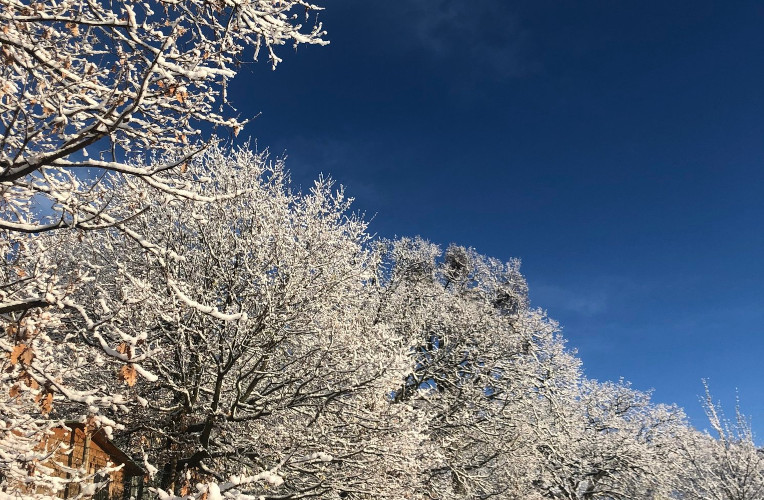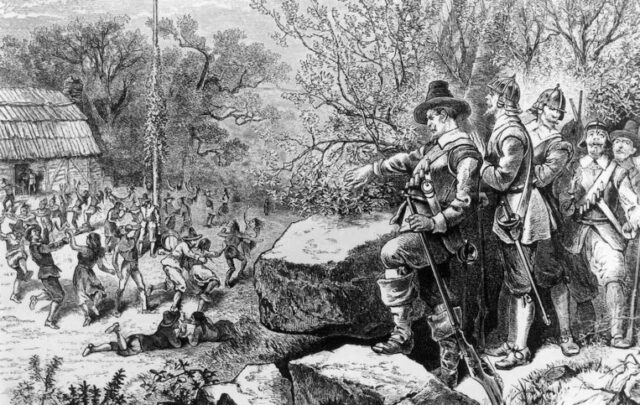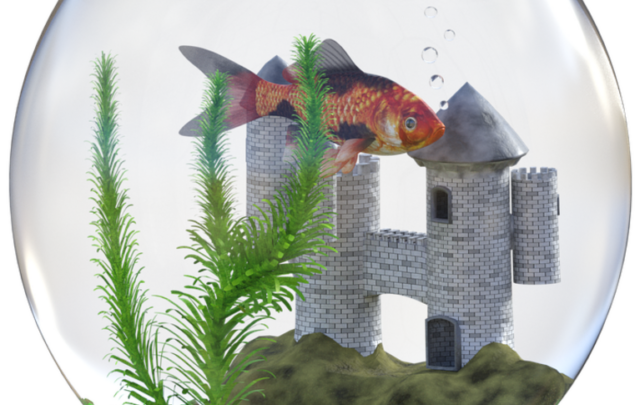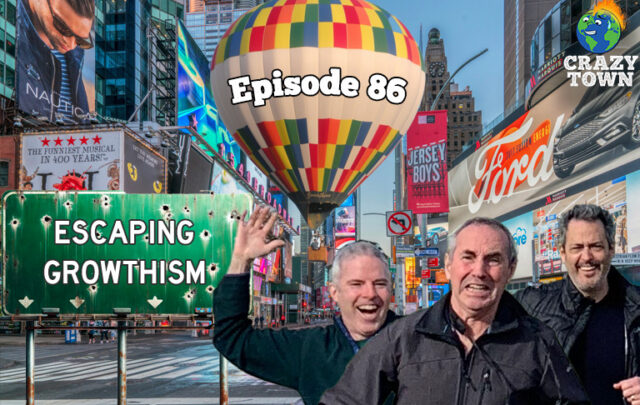Along our road ripening persimmons hang like Christmas ornaments on the bare limbs of trees. And every year, in late December, our neighbor Diego arrives at our door with a crate of yuletide cheer; a box of his just-ripe persimmons, improbably orange and succulent. They belong to the winter solstice, a symbol of the rebirth of the sun. I place a few on the fireplace mantle next to the cedar boughs and candles. Long before Christmas trees were brought inside, evergreen branches were placed over all the openings to the home—the doors and windows, the hearth. Vibrant green life, they are an ancient talisman in deep winter, the triumph of life over death during the darkest time of the year. And this year seems darker than ever before.
The weeks leading up to the winter solstice are my time out, a time to nourish myself, store up energy. Years ago, when I was teaching an adult education class, I received the perfect gift from a student. I was talking (and talking) about plant dormancy—that with the diminishing sunlight and the temperature dropping, the plant’s survival strategy is to slow it’s metabolic activity, to stop growing. This student commented—to no one in particular—if I don’t pull in during the winter, I can’t become expansive in the spring. I was gobsmacked. This was the first time I had an explanation of my major late December pursuits, sloth and retreat. Since then I am unapologetic about going into hibernation, unrepentant about doing next to nothing, recharging, incubating ideas.

Deep winter is traditionally the farmer’s holiday. The living world, my world, has slowed down. In early August I began planting out all the late fall and winter vegetables, staggering the seeding every three weeks. All the crops growing in the gardens now are cold hardy and seem happy enough in the snow. The garlic and onions, the salad greens and fava beans were all planted by November. The cupboards are full of canned and dried summertime. There is nothing to plant, no armada of snails to fend off, no heat to complain about… Yes, there are always a few chores. Not many. The seedlings which will become spring and summer gardens will not be sown until mid-January’s waxing moon. Sunrise waits until 7:30. Feeding and cleaning the animals takes two of us less than an hour and we enjoy the visits. My only exercise is shovelling shit and raking leaves and I am grateful for it. Most of the predators are deep in their borrows, their young are grown and none are birthing now. I am no longer on call as local midwife, forester, and sheriff. I eat a leisurely breakfast. By noon the fog is just beginning to lift and I sit on the stone wall with the sun on my face, the best seat for tree watching in the valley. I still harvest vegetables and cook meals. But I am on my own schedule now. It is dark when we close the barns at five o’clock and the long quiet evening is my own. A stone fireplace heats the room we are in. Piles of books which have waited months are opened. Sometimes I feel that I am sitting on a clutch of eggs, turning them occasionally, but I have no idea what I am hatching out.

Doing little has led to some wonderful discoveries about this mountain I adopted (or did it adopt me?) But I had to consciously slow down first to see its beauty in winter. In the summer, with feet and hands planted in the earth, my attention is always focused on the soil. There are things I miss by not looking up. Bare branches dance in the wind with the same grace as the young deer leaping across the field. The young oaks, still holding onto their leaves, are golden in the sunlight. And my valley is GREEN, greener perhaps than in mid-summer. Moss is growing thick on trees. The fields are lush with fava and spinach. On a grey day, the range of colors in Demeter’s winter wardrobe stands out even more. With the deciduous trees unclothed, the pines and cedars and spruce are in their glory. On the frigid mornings of snow, I linger at the window with a second cup of tea, mesmerized by the arrival overnight of a frozen glistening fairyland and hoping the chickens will forgive me for coming late.
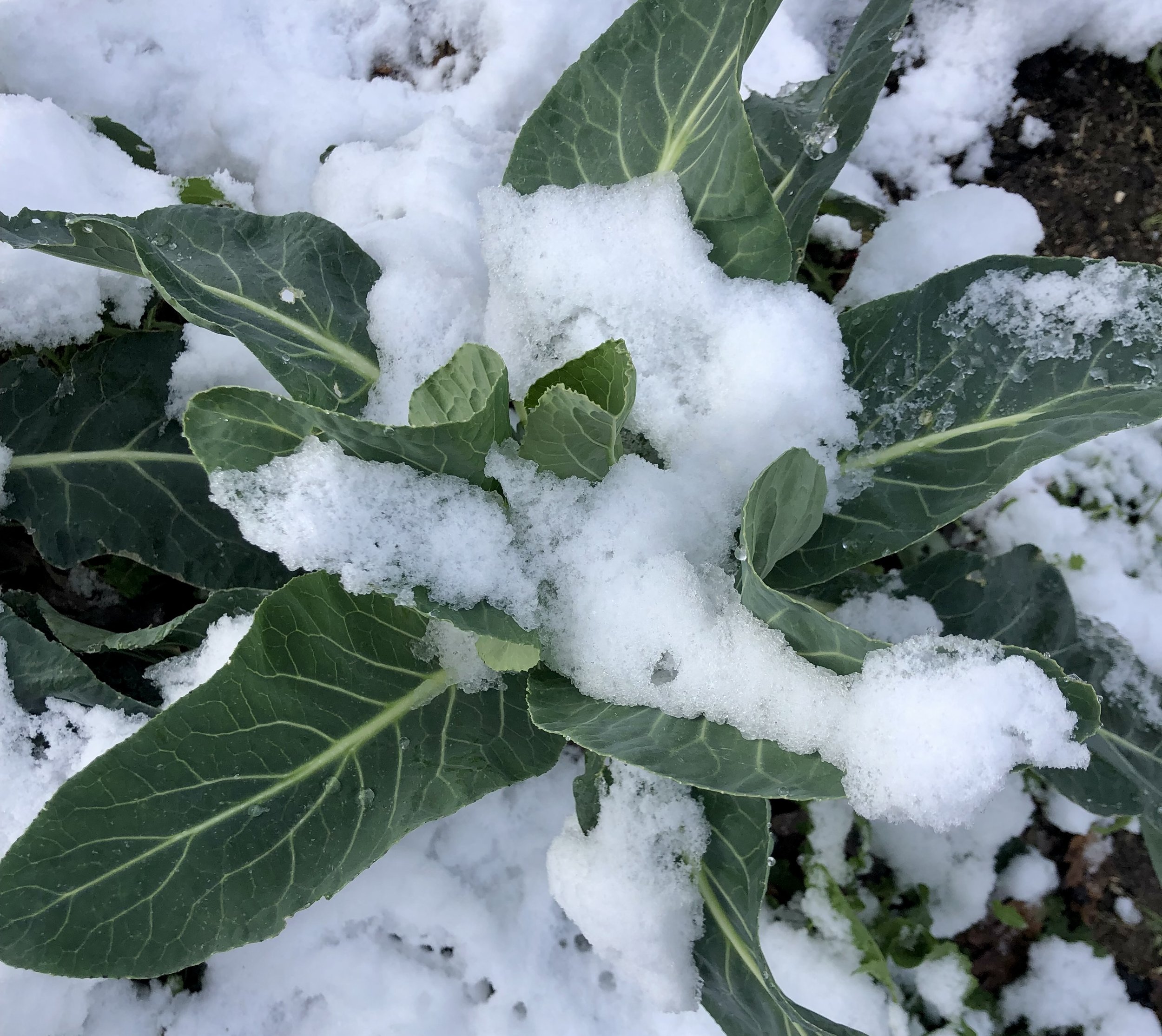
But there is a downside now. It has been creeping in slowly over the years. When I look up, look past the work which centers my days, I know that all is not right. And it hasn’t been for years. There are fewer wild predators but those which make it over or under our fences are fiercer, hungrier. Not one of my neighbors needs a climate scientist to tell them that the snow on top of our mountain comes two months later than it did years ago or that the grasshoppers have become more of a plague than a novelty. The farmers are moving into winter crops, letting their fields go fallow in summer after the wheat is cut in June. And the summers are not just hotter and drier, the winters colder and wetter now there is a fierce wind. It is the wind which frightens me the most, more than the flooding and the drought. He is far stronger than I can remember. I thought myself oh-so-clever to outguess the north wind and put up several rows of laurel bushes as a wind break. But we live on a mountainside and now the wind whips down the mountain from any direction it chooses flattening crops and ripping off tree limbs.
I am always aware, always grateful, for my good fortune. I can make a living and honor my passion on this land, living in the seasons. I live in deep country, within natural beauty, in an ancient farming and foraging culture. Collectively we can feed ourselves. But even if I never read the newspaper the weather alone would make me worry. In past Januarys, with the infant sun growing in the sky, I began to dream the next stage of the farm out of the ether and onto paper, re-evaluating what worked and what did not. By late February I couldn’t wait to get back into the soil. But now, like many others, there are days when I am overwhelmed by the speed of our race toward the abyss—and I despair. The world outside my sweet valley makes no sense to me. Its a challenge to not use this season to dance as fast as I can or yield to depression. I must go within to restore myself, to find solidity, peace, calm… in order to go on... words borrowed from Thich Nhat Hanh. They are, for me, the perfect definition of how I hope to use the winter solstice.

More than ever before, my goal is to go into the darkness. I am not so much looking for answers as providing the space for them to come in. I will continue to revel in the beauty of this land but I am paying attention to the dark clouds, to the long black nights, to the shadows, and what my role is. I now must look at the birth of the sunlight as a time of starting over—from scratch—not just repeating the same things I did in the past. Whatever we have been doing to bring about awareness and change, collectively or individually, is not working. If the word is spreading, it is spreading too slow, too late. This year, I need to do more that just pull within and begin again. Or perhaps it is not about doing more but doing it differently. There is a wisdom to this time of the year. Perhaps by just sitting with the dark, the seeds of whatever I must do next will arrive on their own.
If I don’t pull in during the winter, I can’t become expansive in the spring.



